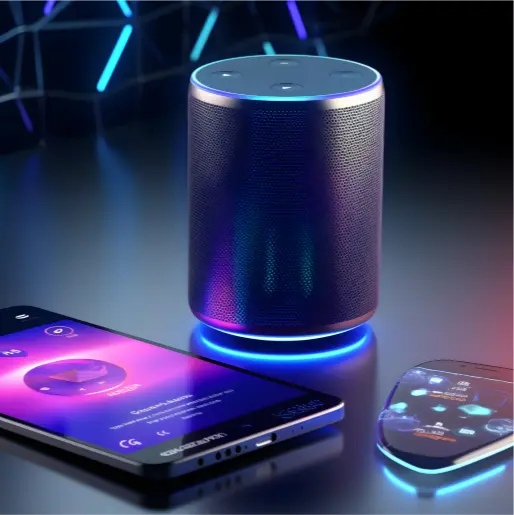Table of Contents:
Voice Commerce!
Related Stories
Explore how smart speakers and voice assistants are revolutionizing online shopping through voice commerce. Discover the evolution, growth, and future of this hands-free shopping trend, and learn how it’s transforming consumer behavior and e-commerce strategies.
In an era where technology is seamlessly woven into the fabric of our daily lives, smart speakers and voice assistants have rapidly emerged as integral tools, revolutionizing how we interact with the digital world. These devices, powered by advancements in artificial intelligence (AI) and natural language processing (NLP), are no longer just novelty gadgets; they have become essential household companions. Among the many ways smart speakers are transforming our lives, one of the most significant is their role in reshaping the shopping experience through voice commerce.
Voice commerce, the process of making purchases using voice commands through smart speakers or voice assistants, is gaining momentum at a remarkable pace. What began as a convenient method for reordering items or checking the weather has evolved into a full-fledged shopping channel, fundamentally altering how consumers engage with online retail. This blog post delves into the rise of voice commerce, exploring its evolution, mechanics, growth, impact on traditional e-commerce, and future potential.
The Evolution of E-Commerce

E-commerce has come a long way since its inception in the mid-1990s when the first online stores began to appear. In its early days, e-commerce was characterized by simple websites offering basic product catalogs and limited payment options. However, as the internet grew in popularity and technology advanced, so did the capabilities of online shopping platforms.
The introduction of secure payment gateways and the proliferation of broadband internet in the early 2000s led to a significant increase in online shopping. Consumers became more comfortable with the idea of purchasing goods and services online, and e-commerce began to flourish. The convenience of shopping from home, coupled with the ability to compare prices and read reviews, made e-commerce an attractive alternative to traditional brick-and-mortar retail.
As smartphones became ubiquitous, mobile commerce (m-commerce) emerged as the next evolution of online shopping. M-commerce allowed consumers to shop on the go, further increasing the convenience and accessibility of e-commerce. Mobile apps and optimized websites made it easier for consumers to browse and purchase products from their smartphones, leading to a surge in online sales.
Today, we are witnessing the rise of a new era in e-commerce: voice commerce. This latest evolution is driven by advancements in AI and NLP, which have enabled the development of sophisticated voice assistants capable of handling complex shopping tasks. Voice commerce represents a natural progression from traditional online shopping and m-commerce, offering consumers a hands-free, intuitive way to make purchases.
The Mechanics of Voice Commerce
Voice commerce operates on the technology backbone of smart speakers and voice assistants, such as Amazon Alexa, Google Assistant, and Apple Siri. These devices utilize AI and NLP to understand and respond to voice commands, allowing users to interact with them in a conversational manner. The technology behind voice commerce can be broken down into several key components:
Natural Language Processing (NLP): NLP is the branch of AI that enables computers to understand, interpret, and respond to human language. Voice assistants use NLP to process spoken language, recognize intent, and generate appropriate responses. This technology allows voice assistants to comprehend complex commands, such as “Order my usual groceries,” and execute the task accordingly.
Voice Recognition: Voice recognition technology enables smart speakers to identify and authenticate users based on their voice patterns. This is crucial for personalizing the shopping experience and ensuring that only authorized users can make purchases. For example, a voice assistant might recognize the primary user of the device and suggest products based on their past shopping behavior.
Machine Learning (ML): Machine learning algorithms allow voice assistants to improve over time by learning from user interactions. The more a user engages with a voice assistant, the better it becomes at understanding their preferences and providing relevant recommendations. This personalized approach is a key driver of voice commerce’s appeal.
Integration with E-Commerce Platforms: Voice assistants are integrated with e-commerce platforms like Amazon, Google Shopping, and Apple Store, enabling seamless voice-activated transactions. These platforms store user preferences, payment details, and order histories, making it easy for voice assistants to process orders quickly and efficiently.
Common examples of voice commerce transactions include:
Ordering Groceries: Users can add items to their shopping cart, review the cart, and complete the purchase—all through voice commands. For instance, saying “Alexa, add milk to my shopping list” can initiate a grocery order.
Reordering Household Items: Voice commerce is particularly useful for reordering frequently purchased items. A user might say, “Hey Google, reorder toilet paper,” and the assistant will place the order based on previous purchases.
Purchasing Digital Content: Voice assistants can also facilitate the purchase of digital content, such as music, movies, or e-books. For example, a user might ask, “Siri, buy the latest Stephen King novel on Apple Books.”
The convenience and efficiency of voice commerce are among its most significant advantages. By eliminating the need to type or navigate a website, voice commerce allows consumers to make purchases quickly and effortlessly. This hands-free shopping experience is particularly appealing in situations where users are multitasking or unable to use their hands, such as while cooking or driving.
The Growth and Adoption of Voice Commerce

Voice commerce is experiencing rapid growth as more consumers adopt smart speakers and voice assistants in their homes. According to a report by Juniper Research, voice commerce sales are expected to reach $80 billion per year by 2023, up from $2 billion in 2018. This explosive growth is driven by several factors:
Proliferation of Smart Speakers: The number of smart speakers in homes has been steadily increasing. As of 2024, it is estimated that over 200 million smart speakers are in use globally. This widespread adoption is fueled by the affordability of devices like Amazon Echo, Google Nest, and Apple HomePod, which offer consumers an easy entry point into the world of voice commerce.
Rising Number of Transactions: As more consumers become comfortable using voice assistants for shopping, the number of voice commerce transactions is on the rise. A survey by Voicebot.ai found that 45% of smart speaker owners have used voice commands to make a purchase at least once, and 22% do so regularly. This trend indicates a growing reliance on voice assistants for everyday shopping needs.
Consumer Demographics and Behavioral Trends: Voice commerce appeals to a broad demographic, but certain groups are more likely to adopt this technology. Younger consumers, particularly Millennials and Gen Z, are more inclined to use voice assistants for shopping due to their familiarity with technology and preference for convenience. Additionally, busy parents and professionals find voice commerce appealing because it allows them to make purchases without interrupting their daily routines.
Key Industry Players: Major tech companies like Amazon, Google, and Apple are at the forefront of promoting voice commerce. Amazon, in particular, has leveraged its dominant position in the e-commerce market to integrate voice commerce seamlessly into its ecosystem. The Amazon Echo, powered by Alexa, is one of the most popular smart speakers, and Amazon has made it easy for consumers to shop using voice commands. Google and Apple are also investing heavily in voice commerce, with Google Assistant and Siri offering similar capabilities.
The Impact on Traditional E-Commerce

The rise of voice commerce is having a profound impact on traditional e-commerce, reshaping consumer behavior, shopping habits, and expectations. Several key changes are worth noting:
Shift in Consumer Behavior: Voice commerce is changing how consumers approach online shopping. Instead of browsing through websites or mobile apps, users can now make purchases with a simple voice command. This shift towards a more conversational shopping experience is leading to a reduction in time spent on traditional e-commerce platforms, as consumers opt for the convenience of voice commerce.
Transformation of the Customer Journey: The traditional e-commerce customer journey typically involves several steps, including product discovery, research, comparison, and finally, purchase. Voice commerce streamlines this process by allowing consumers to skip some of these steps. For example, a user might ask their voice assistant to “order toothpaste” without specifying a brand or comparing prices, relying on the assistant’s recommendations based on past purchases or default settings. This has implications for online retailers, who must adapt their strategies to capture consumer attention in this new environment.
Challenges for Traditional E-Commerce Businesses: As voice commerce gains traction, traditional e-commerce businesses face several challenges. One of the biggest challenges is visibility. In a voice-driven shopping environment, consumers are less likely to browse and compare products, making it harder for lesser-known brands to gain exposure. Additionally, the reliance on voice assistants’ recommendations can limit consumer choice, as users may default to the brands or products suggested by the assistant.
Opportunities for Innovation: Despite these challenges, voice commerce also presents opportunities for innovation. Online retailers can capitalize on the rise of voice commerce by optimizing their product listings for voice search and developing voice-enabled apps or skills for smart speakers. By embracing voice commerce, businesses can stay competitive and meet the evolving needs of consumers.
The Future of Voice Commerce

As voice commerce continues to grow, its future looks promising, with several emerging trends and technologies poised to shape its trajectory:
AI-Driven Personalized Shopping Experiences: The integration of AI into voice commerce will enable even more personalized shopping experiences. Voice assistants will become better at understanding individual preferences and tailoring recommendations accordingly. This could lead to a more customized and efficient shopping experience, where consumers receive suggestions that align with their tastes and needs.
Improved Voice Recognition and Security Measures: Advances in voice recognition technology will enhance the accuracy and security of voice commerce. Voice assistants will become more adept at distinguishing between different users and authenticating purchases, reducing the risk of unauthorized transactions. Additionally, the implementation of biometric authentication, such as voiceprints, could further bolster security.
Expansion of Voice Commerce Capabilities: As technology continues to evolve, the capabilities of voice commerce will expand. Consumers can expect to see more complex.
Conclusion
Voice commerce is more than just a fleeting trend; it represents a fundamental shift in how consumers interact with the digital marketplace. As smart speakers and voice assistants become increasingly embedded in our daily lives, the convenience and efficiency of voice commerce will continue to drive its adoption.
This new shopping method is reshaping consumer behavior, streamlining the purchasing process, and challenging traditional e-commerce models. For businesses, the rise of voice commerce presents both opportunities and challenges. Adapting to this new landscape will be crucial for staying competitive in an ever-evolving market. By embracing the advancements in AI, NLP, and voice recognition technology, retailers can unlock the full potential of voice commerce, offering personalized, secure, and seamless shopping experiences that meet the demands of modern consumers.
External Reference
For further insights into the growth and impact of voice commerce, you can explore the following resources:
Harvard Business Review: This article discusses how voice assistants are transforming the shopping experience by integrating voice interfaces across various customer touchpoints, from smart speakers to websites and apps. Read More….
Businessner: This piece explores the rise of voice commerce, highlighting how smart speakers like Amazon Echo and Google Home are becoming popular tools for online shopping. It delves into the impact of voice commerce on the customer journey and the future of e-commerce. Read More…
Awesome Dynamic: This blog post explains how voice commerce, or v-commerce, allows people to shop using virtual assistants like Alexa, Google Assistant, or Siri. It emphasizes the growing popularity of voice-enabled gadgets and their integration into daily routines. Read More…
IBSW: This article provides insights into how purchases can be made through voice commerce on supported e-commerce platforms by interacting with smart assistants like Siri, Alexa, or Google Assistant. Read More…












